
12/24/2013
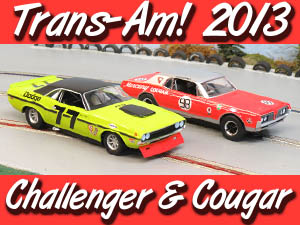
When
the racing series debuted in 1966, it was officially known as the
Trans American Sedan Series. While it became hugely popular during the height of the Pony Car Wars in later years, the
series barely garnered any coverage in any of the popular magazines
at the time. Broken into two classes of over and under 2.0 liter
motors, the Trans-Am Series was originally structured as a manufacturer's
championship. While the early contenders from Ford and Chrysler
comprised of teams running Mustangs, Darts and Barracudas, it was
only a matter of time before more manufacturers jumped into the fray.
And jump, they did! At the height of the Trans-Am craze, every major
automobile manufacturer was participating and the cars that raced on Sunday
looked pretty close to the one that John Q. Public could buy at his local
dealership on Monday.
Fortunately for those of us Trans-Am and slot car racing enthusiasts, Scalextric released the first of their Trans-Am cars back in 2002. And just as the real Trans-Am Series thrust Pony Cars into popularity, the Scalextric 1969 Camaro and Mustang imitated reality. On home and club tracks around the world, Trans-Am racing was suddenly all the rage. It was actually these cars that pulled me over to the "Dark side" of slot cars in 1:32 scale. With the introduction of these cars I suddenly found myself building a permanent track for them and researching each and every car from the series.
Despite the incredible popularity of these cars though, it would be a very long time until Scalextric would release another all-new body in their 1970 Camaro. With the exception of SCX, who jumped into the fray with their excellent 1970 AAR 'Cuda, the cottage industry was forced to step in to fill the void for enthusiasts by providing alternate body kits. For me, it was the only way to own the cars I wanted to drive on my track. Until now, the slot car racer has only had a few choices when it came to running a Cougar on their home track – the vintage (and poorly done) Revell version, the RMS Resins version introduced in 2008 and the recently released version by George Turner Models. The Challenger has also only been available in resin form from RMS Resins - like I said, I wanted these particular cars.
Trans-Am fans can now rejoice though - after years of drought in this series, Scalextric has really upped their game with two brand-new releases – the 1967 Mercury Cougar and the 1970 Dodge Challenger. At first blush, the 1967 Cougar may seem to be a strange car for them to make. After all, there are many other cars not yet represented in 1:32 not to mention the fact that most folks outside of the USA would be hard pressed to tell you much about this particular brand of car. Releasing the 1970 Challenger makes perfect sense though as they have already released both the 1970 Camaro and 1970 Mustang. Strange or not, let's take a look, starting with Dan Gurney's 1967 Cougar!
1967 Mercury Cougar - #98 Dan Gurney
Photo taken on the PDR by David Reinecke
After Ford's success wining the 1966 manufacturer's championship, Lincoln-Mercury brought in Bud Moore to form a Trans-Am team for the 1967 season. The team “stars” were Parnelli Jones and Dan Gurney, but also included Ed Leslie, and Peter Revson. David Pearson was even used as a guest driver once at Mid-Ohio. Because Gurney and Parnelli were often racing in other series, it was in fact Revson and Leslie that did most of the testing on the cars prior to the season, and much of the racing during the season.
While the Cougar was driven hard and well enough to win four races to equal the Mustang's record in 1967, a Mustang driven by Ronnie Bucknum placed just ahead of Gurney at Kent and secured the 1967 championship for Ford by a scant 2 points. Having watched the Mustangs and Cougars swap paint all season and after examining the cost of bankrolling two efforts, Ford decided to go with only the Mustang and canceled the Cougar program after the 1967 season. It was a sad ending for a great team and an iconic car.
The Scalextric version as released in December of 2013, is liveried as the #98 Dan Gurney car. While most people may associate him with the #16 car, in reality the numbers on the cars were switched around quite a bit between the drivers. The #98 car as shown here was run by Gurney at Green Valley, TX and Kent, WA. The livery on the car as modeled here is identical to how it currently runs in the Historic Trans-Am races. If you would like to continue learning about this incredible racing car and how manufacturers made them eligible to race, I encourage you to read the following article on Homologating the Cougar for Trans-Am racing.
So how did Scalextric do? At first glance, fantastic! Scalextric has really done an great job capturing the body of the Cougar. Not only is the shape very good but the proportions are as well, something that is often difficult to properly achieve when dealing with an automobile in a smaller scale. I do feel that the lower rear valance panel is a little short, but nothing that looks bad in my eyes. Interestingly, Scalextric chose to model the car with the headlight covers open as numerous pictures depict the cars later in the season. This really serves two purposes as it allows them to model a racing car and provide a street car with functional headlights later. When you look at the inside of the body shell, this becomes readily apparent. I really love the fact that they have replicated the correct adornment on the nose of the car. Their efforts in getting the car accurate can be seen in comparing measurements to the real car as listed in the chart below. In my opinion, Scalextric did a very good job getting it close to scale without sacrificing too much on looks.
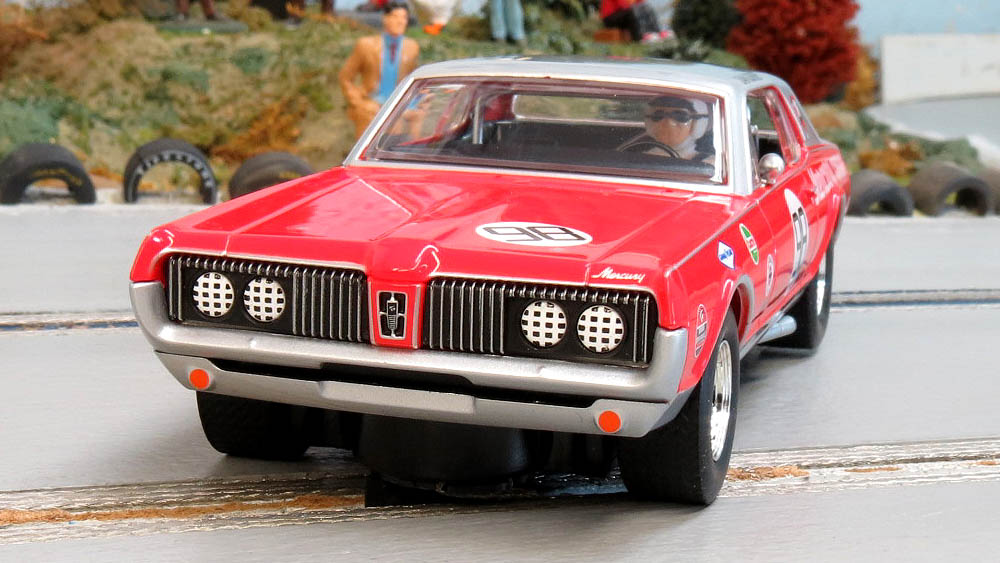
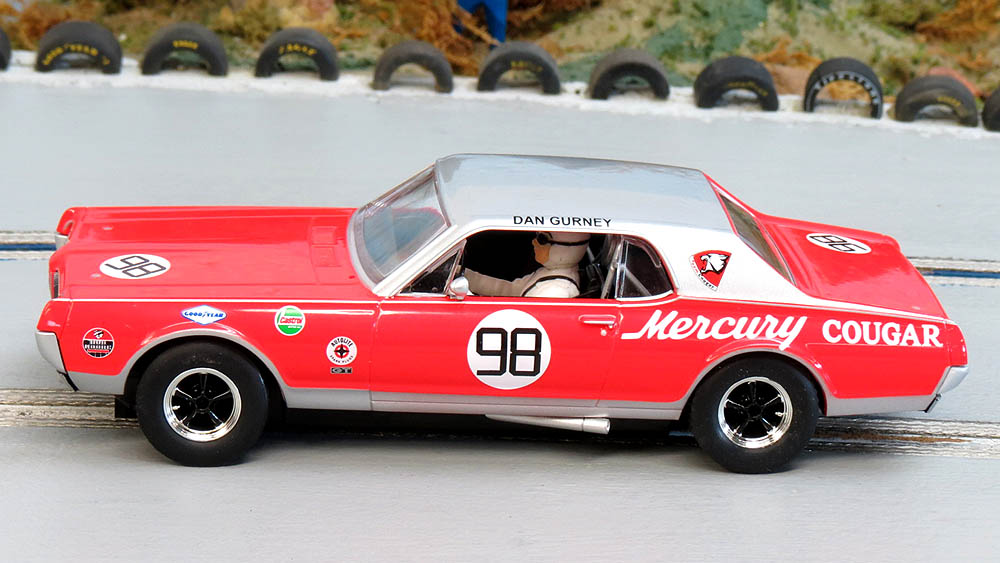
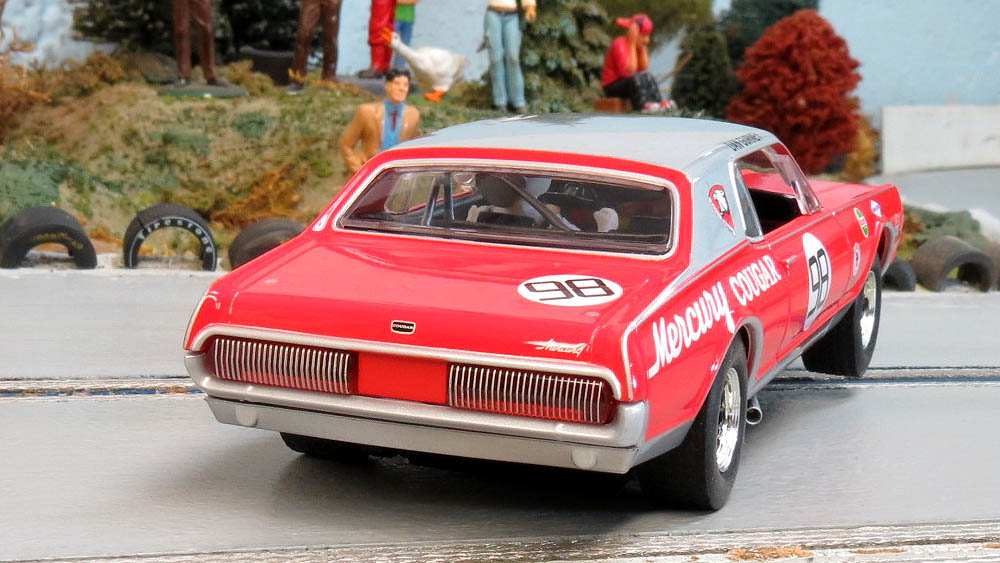
Photos taken by Harry Wise
Data At A Glance – 1967 Cougar
|
Scalextric 1:32 Scale |
Real 1:1 Scale |
|
Length- 149.80 mm |
Length – 150.8mm |
|
Width - 57.50 mm |
Width – 56.5 mm |
|
Height - 40.50 mm |
Height – 41.11 mm |
|
Wheelbase – 88.10 mm |
Wheelbase - 88.60 mm |
|
Total Weight - 88 grams |
|
The
paintwork on the car is simply gorgeous, with one caveat, which we will get to
in just a moment. My example has no flaws in the paint,
the tampo is crisp, and there appears to be a good deep clear coat. Hood
pins and emblems are also part of the tampo package and are a nice touch.
The silver looks very good and even includes the proper pin striping on the side
of the car as the original car raced with. Now for the caveat: that will be a topic of conversation for some time:
the red
color used here appears to be a several shades lighter in color than almost
all vintage photographs of the original cars. I have looked at
several 1:1 cars painted in the same vintage of Cardinal Red and they are definitely
darker in color. The color is a very vibrant red that appears almost
day-glo when held up in natural lighting. While that may drive some purist scale collectors a
bit crazy, I'm very satisfied with the car as-is even with this mistake. On the track at top
speed the color looks very good and is unmistakably
Dan Gurney's Cougar. As an aside, perhaps Scalextric realizes that many
enthusiasts eyes are not what they used to be and are simply attempting to help
us spot the car during club events... One more note is the windshield
wiper holes are visible. This is undoubtedly due to the pending release of
a street version, but this little detail is so correct on this car!
Turning to the interior, we find a tub that is pretty standard Scalextric issue for those of us familiar with the original T/A cars. That means some minor detailing such as the seats and a decent driver and roll bar. A major improvement over the older cars is the driver's head - this one is at least human and does not resemble Mr. Blobbyhead as was present in the original cars. One thing that some folks might not be happy with is the lack of detail such as gauges and racing paraphernalia such as an on-board extinguisher. If this were an open top car I would probably be disappointed, but find the interior to be enough for my needs. I am very happy to see that the top of the dashboard actually resembles that of a Cougar and not a generic slab. It would have been easy to take that road and I am ecstatic they did not.
Photo by David Reinecke
Scalextric chose to model this car with the wheels it ran later in the series - American Racing 5-spoke wheel that so many teams used. Interestingly, the car actually ran 3 different sets of wheels in 1967; plain steel wheels at Daytona, the styled wheels run in pre-season testing and at Sebring, and the American Racing 5-spokes run at Kent:
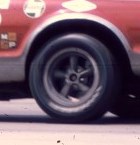
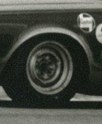
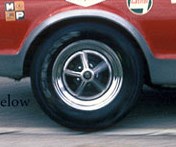
The wheels on the Scalextric version are painted in gloss black with a shiny lip and shod in the large rear tires normally found on the Scalextric T/A cars. While most cars seemed to run these wheels with a dark gray paint on the spokes, I have seen pictures of the wheels exactly like this back in the day. Inexplicably, the same large tires used on the rear wheels of the car are also used in the front and contribute to the front of the car sitting much too tall in the front. This is partially fixed by either reducing the radius on a tire truing machine, or from simply replacing them with a pair of the smaller front tires from the early T/A cars. If you wish to truly and correctly make the car sit prototypically lower, you will have to make some modifications to the chassis and mounting posts. Upon inspecting my sample car the wheels were actually fairly round and out of the box the car ran surprisingly well with minimal hop in the corners. I noted only a small amount of slop in the rear axle and very little flashing on the wheels themselves. Those racing on plastic tracks should have no problems running these cars in stock form. For those racing on routed tracks, only a brief and somewhat normal truing session is needed to get the wheels and tires perfect.
The car disassembles very easily with only 4 screws. Scalextric has seen fit to no longer use screws through the chassis and into the interior. Everything is easily removable for maintenance and is simple to put back together correctly.
Photo by David Reinecke
The chassis appears somewhat similar to the previous Scalextric Trans-Am cars, but during early testing, Harry Wise noted:.
Both models have a bar magnet located in the rear of the car. This is a change from previous releases where the magnet is located in the mid-section of the car. However, the BIG change here is that the magnet in these models is thinner, thus providing LESS magnetic down force.
As the photo shows, on the left is the magnet out of the latest Mustang we reviewed earlier in the year, On the right is the magnet included in both new models. Having the magnet in the rear might help make the cars more of a match to older releases, but my quick track testing still gives the edge to the Mustang.
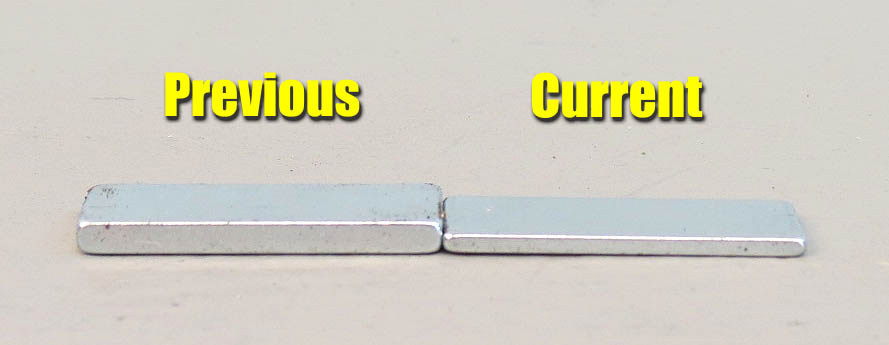
Photo by Harry Wise
I find this very odd and I have to say it could be a mistake. For my personal home racing it means nothing as we race non-magnet. But most enthusiasts race on plastic with the magnets and having this difference likely will not please them. It just does not make sense to change a very important component like the traction magnet in such a long running series as this.
The removal of these magnets is a challenge as the plastic used in this chassis is rather rigid and does not offer much flex to release them. Using a small flat tip screwdriver and pushing from the bottom while carefully flexing the chassis outward seems to be the easiest route to remove them.
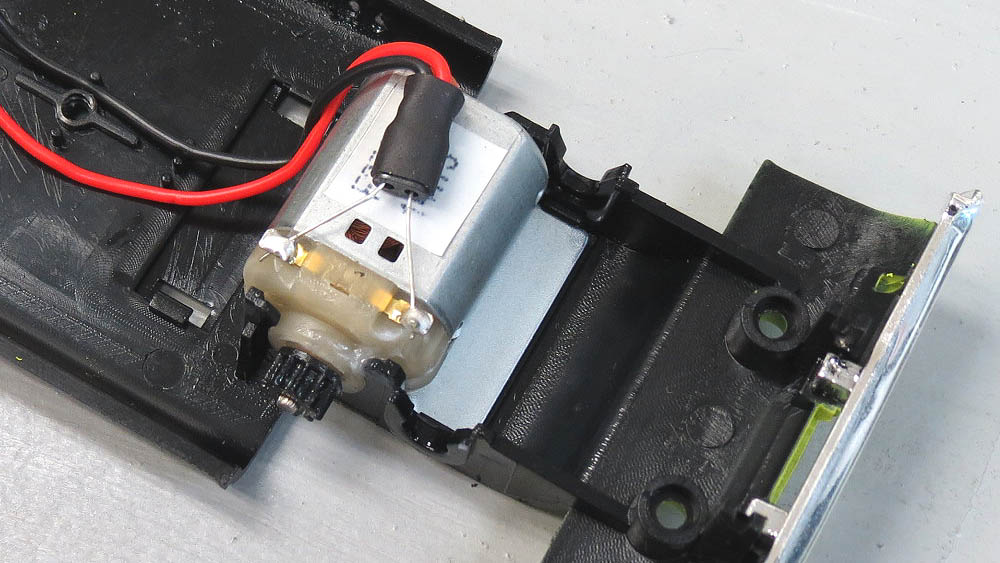
Photo of Challenger Chassis by Harry Wise
Those enthusiasts that race on plastic with the magnets against the older T/A cars will be put out here. Why Scalextric chose to change a very important component like the traction magnet in such a long running series as this is troubling. Extra magnets will need to be added in order to properly match the older cars in the series. One chassis change that is positive is the new guide system that is attached with a screw in the top of the guide. This is a much better system than the older version that likes to disconnect when driven hard. The chassis is also DPR-ready for Scalextric's Digital Racing System, making it easier for those folks to convert these cars to digital format.
Racing on the Palmer Divide Raceway (PDR), the Cougar ran as well as an un-tuned car can on a wood surface: with little traction. After truing the wheels and tires it ran as well as most stock cars with the same treatment. I was happy with how smooth the car seemed with no tuning. Again, a little chatter that can be easily taken care of. Adding silicone or urethane tires will suit most wood track owners, but plastic track racers will have no problem with the stock tires on their tracks as they seem fairly soft. My personal plan is to add Paul Gage PGT-21104 urethane tires to deal with the traction on my wood track. I will also perform my regular tuning on the car in the future: Scalextric Trans-Am Tuning!
Photo taken on the PDR by David Reinecke
In conclusion: This is a great addition to the Trans-Am series! The color may not be the correct shade but the finish of the car is well executed. The front tires and ride height need to be adjusted downward to look more realistic, but this really does not affect the driving of the car in stock form. The magnet changes are going to challenge those magnet racers wanting parity in their field and as a result it may take some fiddling to make this car just as fast as the earlier offerings from Scalextric. However, I think Scalextric has hit a home run, and I cannot wait to get more versions of the Cougar!
I do have one small nit to pick however...the driver's helmet is white - Dan Gurney always used a black helmet and that is something that Scalextric should know. After all, can you imagine the screaming that would have erupted from the other side of the pond had they goofed on Graham Hill's helmet...?
1970 Dodge Challenger - #77 Sam Posey
Photo taken on the PDR by David Reinecke
Virtually abandoning the series after a very successful run with the Dodge Dart in 1966, Dodge decided to come back in 1970 with one of the most brutal looking cars in the series - the Dodge Challenger. Painted in a color called Sublime - one of Dodge's High Impact Paint or H.I.P. Colors, the best description of the car is that it looked like Kryptonite while tearing around the track. Dodge created a T/A version for dealers to sell in order to homologate certain parts such as the special T/A hood. Built by Ray Caldwell's Autodynamics and packing over 450 horsepower from a de-stroked 340, the Challenger did have significant speed, but also teething problems associated with a new program. Just as every car racing in the T/A Series is attached to some funny story about how the team bent the rules, the Challenger's surrounds it's roof. After having been heavily dipped in acid to lighten it, an SCCA official dented the roof of the car simply by resting his elbow on it. Facing disqualification, the team quickly found itself torching the roof off a brand new Challenger that was sitting on a dealer's showroom floor in downtown Monterey. Try that today with a newer car running in NASCAR.
Sam Posey was hired as the primary driver, placing as high as third in three races and in the points six times out of eleven races. The team did occasionally run a spare car that was adorned with the #76 when Ronnie Bucknam drove it at Kent, WA (where the car did not finish) and Tony Adamowicz at the last race in Riverside, CA. Sadly, both Challengers retired at Riverside.
Scalextric has modeled the car as it appeared at the Mid-Ohio race. While many enthusiasts have questioned the livery the car is correct for this race as it did not have the Classic Wax Challenger graphic on the front fender and it sported a big red air dam.
Scalextric did a pretty good job on this car too. The shape of the body on the Challenger is very good, but to me the rear quarter panels look slightly flat and the front wheels seem to sit just a hair too far back in the front wheel well. As mentioned with the Cougar, proportions are often difficult to get perfect in a smaller scale model. However, aside from those two minor issues, the car looks outstanding everywhere else and neither of the two things I mentioned detract from the car for me. I also heartily applaud Scalextric for not flaring the rear wheel wells like the currently restored 1:1 car!
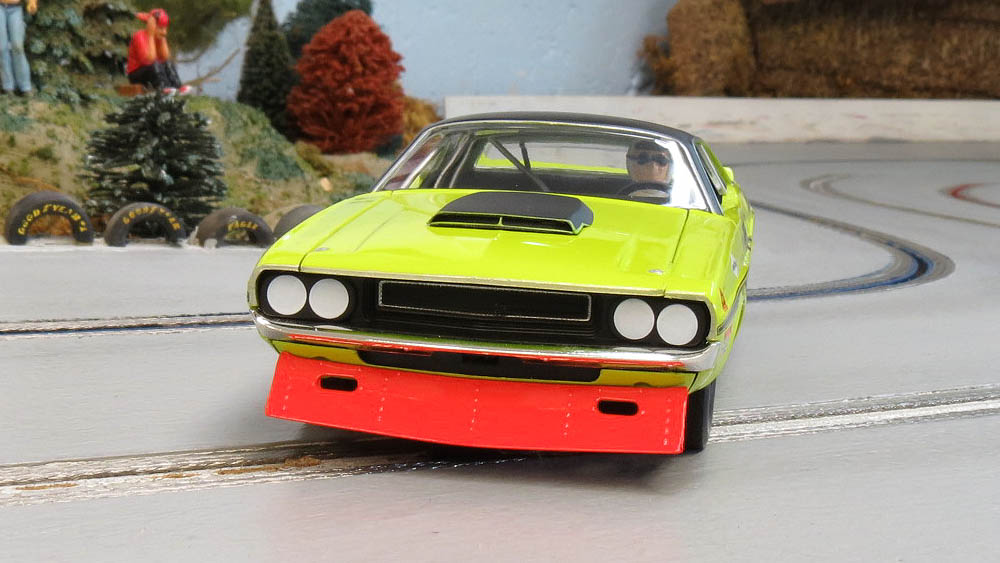
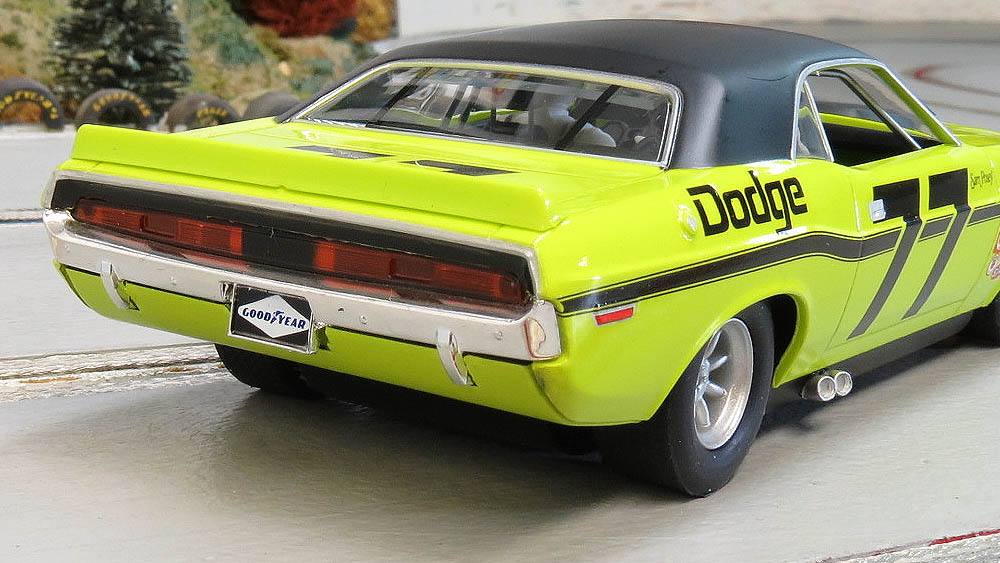
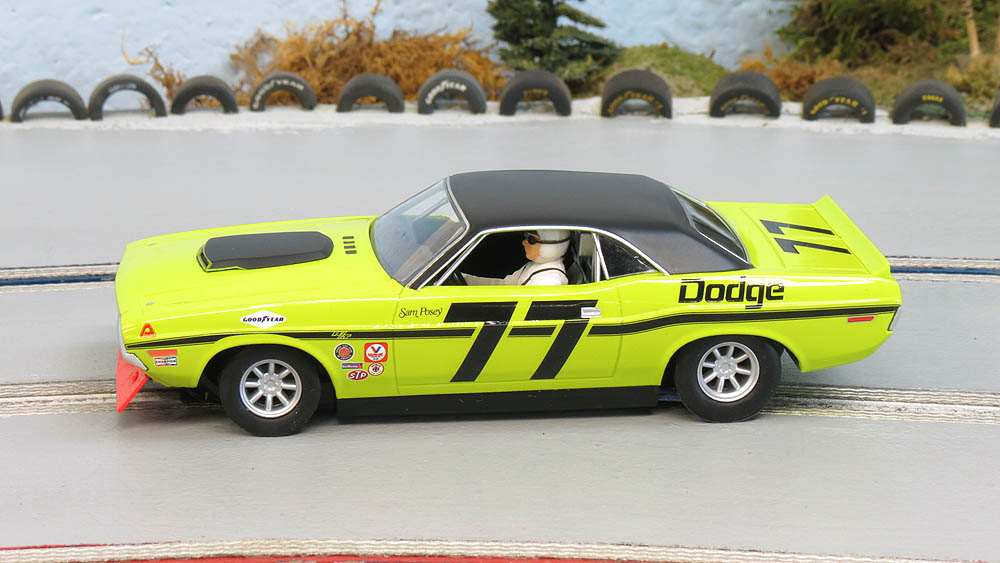
Photos taken by Harry Wise
Data At A Glance – 1970 Challenger
|
Scalextric 1:32 Scale |
Real 1:1 Scale |
|
Length- 149.80 mm |
Length – 151.84 mm |
|
Width - 57.50 mm |
Width – 60.40 mm |
|
Height – 39.30 mm |
Height – 40.40 mm |
|
Wheelbase – 87.45 mm |
Wheelbase – 87.30 mm |
|
Total Weight - 90 grams |
|
The
finish on the Challenger sample I have is simply excellent. It does appear
that the body is not painted but rather that it was molded in the
color with tampo and clear over it. Sublime is not a “normal
green”, but is almost yellow underneath. As done here, the
color looks perfect to my eyes. My sample had no flaws anywhere that
I can find except for a slightly thin place on the fender alongside the
hood. The hood is not molded to the car shell and illustrates how
Scalextric has now done a version with the R/T hood as well as a blower - it is
completely replaceable. Scalextric did a good job faithfully replicating the
black top and the paint treatment around the T/A hood is also very well
executed as is the tampo.
Similar to the Cougar, the interior tub is standard Scalextric issue and while sparse in nature, I am very happy to see that the top of the dashboard actually resembles that of a Challenger and the seats are very close to what my friend's 1970 Challenger had.
Photo by David Reinecke
The Minilite wheels and big tires are correct for how the car ran in 1970 and look good. As noted with the Cougar, the tires will undoubtedly work well on the plastic track they were designed for and will need a little help or possible replacement when used on a wood track. The wheels on my sample were very true with almost no flashing on the wheels and no wobble at all. Having a plastic wheel that true is a rarity and I apparently won the slot car lottery with both of these models!
The chassis is similar to the one used on the Cougar, but the back valance is the biggest one I've ever seen on a slot car! The same issues are noted on the Challenger regarding not only the placement of the magnet, but the thickness of it. This is obviously a planned change, but again I'm not sure the plastic track club racer will appreciate it. The Challenger is also setup for DPR conversion as the Cougar is.
Photo by David Reinecke
As the car is a little lower and heavier than the Cougar, it seems to run a little better right out of the box. I also notice a little less hop in the corners with the Challenger. The rear axle had a little less play than the Cougar's, possibly attributing to this. The car is very smooth at full speed and seems to be as quick as all of my un-tuned Scalextric T/A cars. It also seems a little happier to slide out on the corners than the Cougar does.
Photo taken on the PDR by David Reinecke
In conclusion: Never did I think that Scalextric would make a 1970 Dodge Challenger. I am extremely happy to see that this model was executed as well as it has been. It looks fantastic on the track and even better at speed. I hope that they release the #76 car and perhaps another variant of the #77 from earlier in the season. I would even LOVE to see them release the car in a few other original colors such as Go Mango and Plum Crazy with the same tampo. That would move some more cars for them, keep the Tampo cheap since they already have it, and widen the cars in the field. If they just decided to go completely fantasy with the liveries, I'd buy those too. We just can't have enough of these!
I have to give Scalextric 5 out of 5 gears for both of these cars! With the price points of many cars climbing, Scalextric manages to provide not only two fantastic cars that actually were solid right out of the box, but are able to do so close to the $50 mark. While Scalextric does get bashed at times for quality issues, neither of my cars had any problems that would keep a new slotter from simply enjoying these on the plastic track they were designed for. Experienced slotters will tune these in their normal manner to wring the absolute most out of them.
Now, While Scalextric was Sleeping...
As mentioned previously, only a few options existed prior to Scalextric releasing these models. Not expecting these two cars to ever be covered by a manufacturer, I created my original 1970 Challenger resin kit in 2005 and my 1967 Cougar resin kit in 2008 via Rapid Prototyping. Both cars have been phenomenally successful since their release and are seen racing in homes and clubs around the world.
I've often been asked how I feel when a manufacturer decides to produce a car that I've already made a resin kit of. Honestly? I am thrilled! Being a Trans-Am Series fan, I am excited that new people may be brought into the hobby after seeing these incredible cars in Ready-to-Run (RTR) form at a local store. It also means a longer supply of the chassis that I often use under my own kits!
Now that I have both cars in my hands, I thought it would be interesting to compare both of my kits to the “modern” versions made by computers and factories to see how they stack up. I like both versions personally and am happy to have been racing these for so long prior to having an RTR version to rub paint with. The last of such comparisons I made was after the 1970 Camaro was released. While my version looked good on it's own, next to the Scalextric offering it began to look slightly cartoonish. Hopefully these new ones won't have the same effect on my offerings!
The front of the cars show how much more crisp real computer work can make tooling! Not bad though, considering I started with a horrible die cast.
Scalextric also did better on the color than I did. Funny, I always thought mine was really close to Sublime until putting it next to theirs!
The RMS version wins the low-rider contest here by a large margin.
Again, the Scalextric version shows how much better their tail panel looks.
Obviously, the Scalextric offering is superior to the resin version in both detail and accuracy of the body lines.
The Cougar fares a bit better as it began as a 1:25 model that was scanned with a 3D laser scanner and then Rapid Prototyped. I also molded the headlights closed and prefer that look.
Scalextric tail panel and taillights are certainly more detailed, but I think the resin version is actually fairly close.
This is where the Scalextric version needs some help! I wasn't aware a 4x4 option existed! No matter, some simple tuning and lowering will take care of that issue.
The rear quarters of the Scalextric version are correct and more crisp than the resin version's.
Well, that wasn't too bad! I'm happy to have filled in while awaiting these two cars over the years.
Thank you Scalextric for bringing us these - I'll have a Merry Christmas racing them!
- David
Thanks go to POWERSLOTCARS for sponsoring this review.
Copyright © 2013 HomeRacingWorld.com All Rights Reserved